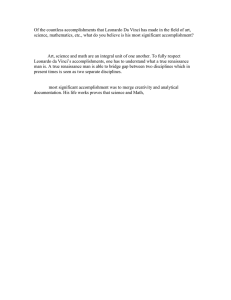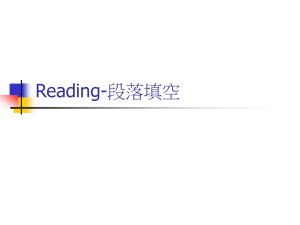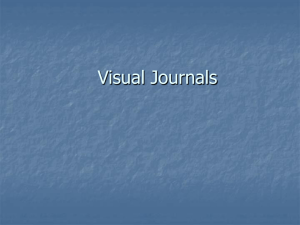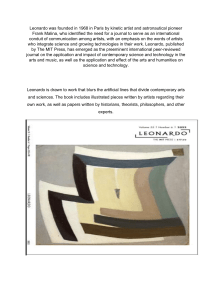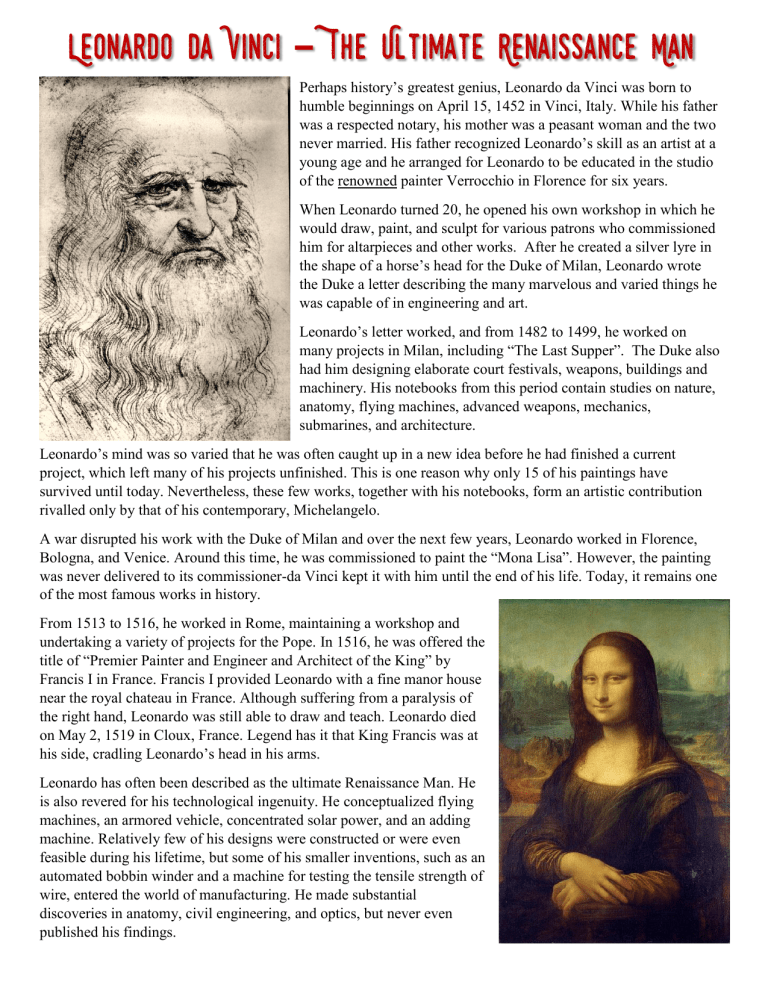
Leonardo da Vinci – The Ultimate Renaissance Man Perhaps history’s greatest genius, Leonardo da Vinci was born to humble beginnings on April 15, 1452 in Vinci, Italy. While his father was a respected notary, his mother was a peasant woman and the two never married. His father recognized Leonardo’s skill as an artist at a young age and he arranged for Leonardo to be educated in the studio of the renowned painter Verrocchio in Florence for six years. When Leonardo turned 20, he opened his own workshop in which he would draw, paint, and sculpt for various patrons who commissioned him for altarpieces and other works. After he created a silver lyre in the shape of a horse’s head for the Duke of Milan, Leonardo wrote the Duke a letter describing the many marvelous and varied things he was capable of in engineering and art. Leonardo’s letter worked, and from 1482 to 1499, he worked on many projects in Milan, including “The Last Supper”. The Duke also had him designing elaborate court festivals, weapons, buildings and machinery. His notebooks from this period contain studies on nature, anatomy, flying machines, advanced weapons, mechanics, submarines, and architecture. Leonardo’s mind was so varied that he was often caught up in a new idea before he had finished a current project, which left many of his projects unfinished. This is one reason why only 15 of his paintings have survived until today. Nevertheless, these few works, together with his notebooks, form an artistic contribution rivalled only by that of his contemporary, Michelangelo. A war disrupted his work with the Duke of Milan and over the next few years, Leonardo worked in Florence, Bologna, and Venice. Around this time, he was commissioned to paint the “Mona Lisa”. However, the painting was never delivered to its commissioner-da Vinci kept it with him until the end of his life. Today, it remains one of the most famous works in history. From 1513 to 1516, he worked in Rome, maintaining a workshop and undertaking a variety of projects for the Pope. In 1516, he was offered the title of “Premier Painter and Engineer and Architect of the King” by Francis I in France. Francis I provided Leonardo with a fine manor house near the royal chateau in France. Although suffering from a paralysis of the right hand, Leonardo was still able to draw and teach. Leonardo died on May 2, 1519 in Cloux, France. Legend has it that King Francis was at his side, cradling Leonardo’s head in his arms. Leonardo has often been described as the ultimate Renaissance Man. He is also revered for his technological ingenuity. He conceptualized flying machines, an armored vehicle, concentrated solar power, and an adding machine. Relatively few of his designs were constructed or were even feasible during his lifetime, but some of his smaller inventions, such as an automated bobbin winder and a machine for testing the tensile strength of wire, entered the world of manufacturing. He made substantial discoveries in anatomy, civil engineering, and optics, but never even published his findings. Name _______________________________ Leonardo da Vinci – The Ultimate Renaissance Man Directions: After reading about Leonardo da Vinci, answer the following questions. 1. What is the best definition of “renowned” as it is used in the first paragraph? a. Clever b. Famous c. Handsome d. Believable 2. Read this sentence from paragraph 4: Leonardo’s mind was so varied that he was often caught up in a new idea before he had finished a current project, which left many of his projects unfinished. This sentence implies that Leonardo da Vinci was – a. Meticulous b. Familiar c. Grounded d. Distracted 3. How might Leonardo’s legacy be different today if he had been more focused on finishing each work he started? 4. Which of these is an opinion expressed in the article? a. “Perhaps history’s greatest genius…“ b. “His notebooks from this period contain studies on nature…” c. “…war disrupted his work with the Duke of Milan…” d. “…suffering from a paralysis of the right hand Leonardo was still able to draw…” 5. What belongs in the missing box from this flow chart about the article? Leonardo learns from Verrocchio. a. b. c. d. Leonardo works for the Duke of Milan. ? Leonardo becomes the “Premier Painter and Engineer and Architect of the King” Leonardo paints “The Last Supper” Leonardo opens his own workshop. Leonardo teaches in France. Leonardo works on projects for the Pope in Rome. 6. In what way was Leonardo da Vinci a “Renaissance Man”? Do you agree or disagree that he was the “ultimate Renaissance Man”? Explain your answer with details you learned about him. Name __Answer Key/Teacher’s Guide______ Leonardo da Vinci – The Ultimate Renaissance Man Directions: After reading about Leonardo da Vinci, answer the following questions. 7. What is the best definition of “renowned” as it is used in the first paragraph? a. Clever b. Famous c. Handsome d. Believable 8. Read this sentence from paragraph 4: Leonardo’s mind was so varied that he was often caught up in a new idea before he had finished a current project, which left many of his projects unfinished. This sentence implies that Leonardo da Vinci was – a. Meticulous b. Familiar c. Grounded d. Distracted 9. How might Leonardo’s legacy be different today if he had been more focused on finishing each work he started? Open to various student opinions provided they support their answer with details learned about Leonardo da Vinci. 10. Which of these is an opinion expressed in the article? a. “Perhaps history’s greatest genius…“ b. “His notebooks from this period contain studies on nature…” c. “…war disrupted his work with the Duke of Milan…” d. “…suffering from a paralysis of the right hand Leonardo was still able to draw…” 11. What belongs in the missing box from this flow chart about the article? Leonardo learns from Verrocchio. a. b. c. d. Leonardo works for the Duke of Milan ? Leonardo becomes the “Premier Painter and Engineer and Architect of the King” Leonardo paints “The Last Supper” Leonardo opens his own workshop. Leonardo teaches in France. Leonardo works on projects for the Pope in Rome. 12. In what way was Leonardo da Vinci a “Renaissance Man”? Do you agree or disagree that he was the “ultimate Renaissance Man”? Explain your answer with details you learned about him. Open to various student opinions provided they support their answer with details learned about Leonardo da Vinci. © Students of History - http://www.teacherspayteachers.com/Store/Students-Of-History/ Directions: Leonardo da Vinci was an Italian painter, sculptor, architect, mathematician, engineer, inventor, anatomist, and writer. He is widely considered to be one of the greatest painters of all time and perhaps the most diversely talented person ever to have lived. His famous notebooks contain over 13,000 pages of inventions, sketches, and studies in science and engineering. Cut out top portion as one piece then fold slightly along the solid horizontal middle line so that you can cut the dotted middle portion. Then cut out and slightly roll up the bottom portion and slide it through the hole you cut in the top portion. Align the two pages and you have your book! Fill the pages of your book with your own sketches of Da Vinci’s works. Be sure to include his most famous artistic pieces and notes on their titles and why they are so important. You should also include biographical information about Da Vinci and his impact on the Renaissance. Glue into your notebook here If you would like your students to create larger notebooks for Leonardo da Vinci, you can give each two blank sheets of paper and follow these steps: 1. Fold both sheets of paper in half the long way “hot dog bun style” 2. Take out one sheet and put it inside the other in the reverse direction. 3. Find the middle of the 2 sheets and cut almost the whole way, leaving about 1.5” – 2”. 4. Take the papers apart and you should have one sheet with cuts on the outside (like fish gills) and one sheet with a whole in the middle (like a mouth). 5. Feed the “fish gill” one into the “mouth” one and line them up. 6. Unfold and even out the pages so they overlap into a book! Thank you so much for your purchase! I really do appreciate your support! If you are looking for any more resources to help in teaching about the Renaissance and Reformation, you can find many in my store. Here are some that would fit in well with this resource: Reformation PowerPoint
